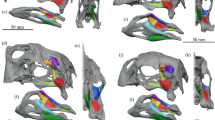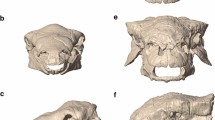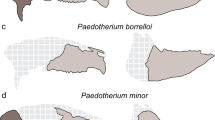Abstract
The function of the jaw apparatus and the possible dietary habits of the aetosaur Neoaetosauroides engaeus from the Triassic of South America were analyzed in comparison with Northern Hemisphere aetosaurs Desmatosuchus haplocerus and Stagonolepis robertsoni and the living short-snouted crocodile Alligator mississippiensis. The adductor and depressor jaw musculature of these was reconstructed on the basis of dental and skeletal comparisons with living closest relatives’ extant phylogenetic bracket (EPB), followed by the analysis of the moment arms of these muscles to infer feeding habits. The aetosaurian skull design indicates that the total leverage of the inferred jaw musculature provides force rather than speed. However, within aetosaurs, the high ratios of muscle moment arms to bite moments indicate stronger bites in the northern Hemisphere forms, and faster ones in Neoaetosauroides. These differences indicate more developed crushing, chopping, and slicing capacities, especially at the back of the tooth series for D. haplocerus and S. robertsoni; whereas it opens a window to consider different abilities in which speed is involved for N. engaeus. There are differences among aetosaurs in dental characteristics, position of the supratemporal fenestra, location of the jaw joint relative to the tooth row, and shape of the lower jaw. Neoaetosauroides does not show evidence of dental serrations and wear facets, probably consistent with a relatively soft and non-abrasive diet, for example soft leaves and/or larvae and insects without hard structures. It might be possible that Neoaetosauroides represents a tendency towards insectivorous feeding habits, exploiting a food source that was widespread in continental environments throughout the Triassic.
Kurzfassung
Die Funktion der Kiefer und die möglichen Ernährungsgewohnheiten des Aetosauriers Neoaetosauroides engaeus aus der Trias von Südamerika wurden mit den Aetosauriern Desmatosuchus haplocerus und Stagonolepis robertsoni aus der nördlichen Halbkugel und dem lebenden kurzschnäuzigen Alligator mississippiensis verglichen. Die Adduktoren und Depressoren der Kiefermuskulatur wurden auf der Grundlage eines Vergleiches der Kiefer und Zähne mit den nächsten lebenden Verwandten rekonstruiert, und die Hebelarme dieser Muskeln wurde analysiert, um Rückschlüsse auf die Ernährungsweise zu gewinnen. Die Struktur des Schädels der Aetosaurier deutet darauf hin, dass die Hebelarme der rekonstruierten Kiefermuskeln eher auf Kraft denn auf ein schnelles Schließen der Schnauze angelegt sind. Allerdings deuten innerhalb der Aetosaurier das hohe Verhältnis der Hebelarme der Kiefermuskeln zu ihren Drehmomenten auf einen kräftigeren Biß bei den Formen aus der nördlichen Halbkugel hin, gegenüber einem schnelleren Biß bei Neoaetosauroides. Diese Unterschiede deuten darauf hin, dass die Kiefer von D. haplocerus und S. robertsoni besser zum zermahlen, schneiden und abbeißen geeignet waren, insbesondere im hinteren Bereich der Zahnreihe, während sie für N. engaeus andere Möglichkeiten eröffnen, bei denen die Schließgeschwindigkeit der Kiefer eine Rolle spielt. Unterschiede zwischen verschiedenen Taxa der Aetosaurier finden sich in der Struktur der Zähne, der Position des Supratemporalfensters, der Lage des Kiefergelenkes in Relation zur Zahnreihe und der Form des Unterkiefers. Neoaetosauroides zeigt keine Anzeichen von Serrationen oder Abnutzungsspuren an den Zähnen, was wahrscheinlich auf eine relativ weiche und nicht-abschleifende Nahrung hindeutet, wie zum Beispiel weiche Blätter und/oder Larven und Insekten ohne harte Panzer. Somit erscheint es möglich, dass Neoaetosauroides eine Tendenz zur insektenfressenden Ernährungsgewohnheiten aufweist, und somit eine Nahrungsquelle ausnutzte, die in kontinentalen Ökosystemen während der Trias überall weit verbreitet war.



Similar content being viewed by others
References
Abdala, V., and S. Moro. 1996. Cranial Musculature of South American Gekkonidae. Journal of Morphology 229: 59–70.
Agassiz, L. 1844. Monographie des poissons fossiles du Vieux Grès Rouge ou Système Dévonien (Old Red Sandstone) des Îles Britanniques et de Russie. France: Jent et Gassman, Neuchâtel.
Barrett, P.M., and E.J. Rayfield. 2006. Ecological and evolutionary implications of dinosaur feeding behaviour. Trends in Ecology and Evolution 21: 217–224.
Bonaparte, J.F. 1969. Los tetrápodos triásicos de Argentina. In First International Symposium of Gondwana, Mar del Plata 1967, Actas: 307–325.
Bonaparte, J.F. 1971. Los tetrápodos del sector superior de la Formación Los Colorados, La Rioja, Argentina (Triásico Superior). In Opera Lilloana, ed. Fundación Miguel Lillo, Tucumán, 22, 87–102.
Bonaparte, J.F. 1978. El Mesozoico de América del Sur y sus tetrápodos. 596 pp. Opera Lilloana 26, Tucumán.
Brochu, C.A. 2001. Progress and future directions in archosaur phylogenetics. Journal of Paleontology 75: 1185–1201.
Burton, P.J.K. 1974. Feeding and the Feeding Apparatus in Waders: a Study of Anatomy and Adaptations in the Charadrii. In Trustees of the British (Natural History), 150 pp. London. ISBN-13: 9780565007195.
Busbey, A.B. 1989. Form and function of the feeding apparatus of Alligator mississippiensis. Journal of Morphology 202: 99–127.
Carrano, M.T., and J.R. Hutchinson. 2002. Pelvic and hindlimb musculature of Tyrannosaurus rex (Dinosauria: Theropoda). Journal of Morphology 253: 207–228.
Cleuren, J., and F. De Vree. 1992. Kinematics of the jaw and hyolingual apparatus during feeding in Caiman crocodilus. Journal of Morphology 212: 141–154.
Cleuren, J. and F. De Vree. 2000. Feeding in Crocodilians. In Feeding: Form, Function, and Evolution in Tetrapod Vertebrates (1st edn), ed. K. Schwenk, 337–358. New York: Academic Press.
Cope, E.D. 1892. A contribution to the vertebrate paleontology of Texas. Proceedings of the American Philosophical Society 30: 123–131.
Desojo, J.B. 2003. Hábitos alimenticios en los aetosaurios: herbívoros, insectívoros o carnívoros? Ameghiniana 40(4): 54R.
Desojo, J.B., and A.M. Báez. 2005. El esqueleto postcraneano de Neoaetosauroides (Archosauria: Aetosauria) del Triásico Superior del centro-oeste de Argentina. Ameghiniana 42(1): 115–126.
Desojo, J.B., and A.M. Báez. 2007. Cranial morphology of the Late Triassic South American archosaur Neoaetosauroides engaeus: evidence for aetosaurian diversity. Palaeontology 50: 267–276.
Elzanowski, A. 1987. Cranial and eyelid muscles and ligaments of the tinamous (Aves, Tinamiformes). Zool. Jah. die Anat. 116: 63–118.
Endo, H., R. Aoki, H. Taru, J. Kimura, M. Sasaki, M. Yamamoto, K. Arishima, and Y. Hayashi. 2002. Comparative functional morphology of the masticatory apparatus in the long-snouted Crocodiles. Anatomy Histolology and Embryology 31: 206–213.
Erickson, G.M., A.K. Lappin, and K.A. Vliet. 2003. The ontogeny of bite-force performance in American alligator (Alligator mississippiensis). Journal of Zoology 260: 317–327.
Fraas, O. 1877. Aetosaurus ferratus, die gepanzerte Vogelechse aus dem Stubensandstein bei Stuttgart. Jahreshefte des Vereins für vaterländische Naturkunde in Württemberg 33: 1–21.
Gower, D.J., and A.D. Walker. 2002. New data on the braincase of the aetosaurian archosaur (Reptilia: Diapsida) Stagonolepis robertsoni Agassiz. Zoological Journal of the Linnean Society 136: 7–23.
Gower, D.J., and M. Wilkinson. 1996. Is there any consensus on basal archosaurs phylogeny? Proceedings of the Royal Society of London, B 263: 1399–1406.
Hasiotis, S.T. 2003. Complex ichnofossils of solitary and social soil organisms: understanding their evolution ad roles in terrestrial paleoecosystems. Palaeogeography, Palaeoclimatology, Palaeoecology 192: 259–320.
Haas, G. 1973. Muscles of the jaws and associated structures in the Rhynchocephalia and Squamata. In Biology of the Reptilia, eds. Gans, C., and Parsons, T.S. 4: 285–490. New York: Academic Press.
Heckert, A.B., and S.G. Lucas. 1999. A new aetosaur from the Upper Triassic of Texas and the phylogeny of aetosaurs. Journal of Vertebrate Paleontology 19(1): 50–68.
Heckert, A.B., and Lucas, S.G. 2000. Taxonomy, phylogeny, biostratigraphy, biochronology, paleobiogeography, and evolution of the Late Triassic Aetosauria (Archosauria: Crurotarsi). Zentralblatt für Geologie und Paläontologie, 1998, Teil I, Heft 11-12: 1539–1587.
Holliday, C.M., and L.M. Witmer. 2007. Archosaur adductor chamber evolution: integration of musculoskeletal and topological criteria in jaw muscle homology. Journal of Morphology 268: 457–484.
Huxley, T. 1859. On the Stagonolepis robertsoni (Agassiz) of the Elgin Sandstone; and on the recently discovered footmarks in the Sandstones of Cummingstone. Proceedings of the Geological Society of London 15: 440–460.
Huxley, T. 1875. On Stagonolepis robertsoni, and on the evolution of the Crocodile. Proceedings of the Geological Society of London 31: 423–438.
Iordansky, N.N. 1964. The jaw muscles of the crocodiles and some related structures of the crocodilian skull. Anatomischer Anzeiger 115: 256–280.
Iordansky, N.N. 2000. Jaw muscles of the crocodiles structure, synonymy, and some implications on homology and functions. Russian Journal of Herpetology 7(1): 41–50.
Juul, L. 1994. The phylogeny of basal archosaurs. Palaeontologia Africana 31: 287–308.
Kardong, K.V. 2002. Welcome to the Vertebrates, 3rd edition Web Site. http://www.mhhe.com/biosci/pae/zoology/kardong/. Accessed 20 August 2006.
Lecuona, A., Bona, P., and Desojo, J.B. 2006. Musculatura craneana de Caiman latirostris (Crocodylia: Alligatoridae): nuevos aportes. In Actas del VII Congreso Argentino de Herpetología (Corrientes).
Mancuso, A.C., O.F. Gallego, and R.G. Martins-Neto. 2007. The Triassic insect fauna from the Los Rastros Formation (Bermejo Basin), la Rioja Province (Argentina): its context, taphonomy and paleobiology. Ameghiniana 44(2): 337–348.
Marsicano, C.A., O. Gallego, and A. Arcucci. 2001. Faunas del Triásico: relaciones, patrones de distribución y sucesión temporal. In El Sistema Triásico en la Argentina, ed. A.E. Artabe, E.M. Morel, and A.B. Zamuner, 131–141. La Plata: Fundación Museo de La Plata “Fransisco P. Moreno”.
McDonald, H.G., S.F. Vizcaino, and M.S. Bargo. 2008. Skeletal anatomy and the fossil history of the Vermilingua. In The Biology of the Xenarthra, ed. S.F. Vizcaino, and W.J. Loughry, 64–78. Florida: University Press.
Murry, P.A., and R.A. Long. 1996. A diminutive carnivorous aetosaur from the Upper Triassic of Howard County, Texas. Journal of Vertebrate Paleontology 16(3): 55A.
Parker, W.G. 2005. A new species of the Late Triassic aetosaur Desmatosuchus (Archosauria: Pseudosuchia). Paleovol 4: 327–340.
Parker, W.G. 2007. Reassessment of the aetosaur ‘Desmatosuchus chamaensis’ with a reanalysis of the phylogeny of the Aetosauria (Archosauria: Pseudosuchia). Journal of Systematic Palaeontology 5: 1–28.
Parrish, J.M. 1993. Phylogeny of the Crocodylotarsi, with reference to archosaurian and crurotarsan monophyly. Journal of Vertebrate Paleontology 13(3): 287–308.
Parrish, J.M. 1994. Cranial osteology of Longosuchus meadei and the phylogeny and distribution of the Aetosauria. Journal of Vertebrate Paleontology 14(2): 196–209.
Perry, S.F., and M. Sander. 2004. Reconstructing the evolution of the respiratory apparatus in tetrapods. Respiratory Physiology & Neurobiology 144: 125–139.
Plotnick, R.E., and T.K. Baumiller. 2000. Invention by evolution: functional analysis in paleobiology. In Deep Time. Paleobiology’s perspective, eds. Erwin D.H., and Wing S.L., 305–321. Supplement to Paleobiology 26.
Poglayen-Neuwall, I. 1953. Untersuchungen der Kiefermuskulatur und deren Innervation an Krokodilen. Anatomischer Anzeiger 99: 257–276.
Redford, K.H. 1985. Food habits of Armadillos (Xenarthra: Dasypodidae). In The Evolution and Ecology of Armadillos, Sloths, and Vermilinguas, ed. G.G. Montgomery, 429–437. Washington: Smithsonian Institution Press.
Ross, C.F., and K.A. Metzger. 2004. Bone strain gradients and optimization in vertebrate skulls. Annals of Anatomy 186: 387–396.
Rieppel, O. 1990. The structure and development of the jaw adductor musculature in the turtle Chelydra serpentina. Zoological Journal of the Linnean Society 98: 27–62.
Rieppel, O. 2002. Feeding mechanics in Triassic stem-group sauropterygians: the anatomy of a successful invasion of Mesozoic seas. Zoological Journal of the Linnean Society 135: 33–63.
Sawin, H.J. 1947. The Pseudosuchian reptile Typothorax meadei. Journal of Paleontology 21(3): 201–238.
Schoch, R.R. 2007. Osteology of the small archosaur Aetosaurus from the Upper Triassic of Germany. Neues Jahrbuch für Geologie und Paläontologie 246: 1–35.
Schumacher, G.H. 1973. The head muscles and hyolaryngeal skeleton of turtles and Crocodilians. In Biology of the Reptilia, eds. C. Gans and T.S. Parsons 4, 101–199. New York: Academic Press.
Schumacher, G.H. 1985. Comparative functional anatomy of jaw muscles in reptiles and mammals. Fortschritte der Zoologie 30: 203–212.
Sereno, P.C., and A.B. Arcucci. 1990. The monophyly of crurotarsal archosaurs and the origin of bird and crocodile ankle joints. Neues Jahrbuch für Geologie und Paläontologie 180(1): 21–52.
Small, B.J. 1985. The Triassic thecodontian reptile Desmatosuchus: osteology and relationships. Unpublished MSc thesis, Texas Tech University, Lubbock, Texas, 315 pp.
Small, B.J. 2002. Cranial anatomy of Desmatosuchus haplocerus (Reptilia: Archosauria: Stagonolepididae). Zoological Journal of the Linnean Society 136: 97–111.
van Drongelen, W., and P. Dullemeijer. 1982. The feeding apparatus of Caiman crocodilus; a functional-morphological study. Anatomisher Anzeiger 151: 337–366.
Vizcaíno, S.F., M.S. Bargo, R.F. Kay, and N. Milne. 2006. The armadillos (Mammalia, Xenarthra) of the Santa Cruz Formation (Early-Middle Miocene). An approach to their paleobioloy. Palaeogeography, Palaeoclimatology, Palaeoecology 237: 255–269.
Vizcaíno, S.F., G. De Iuliis, and M.S. Bargo. 1998. Skull shape, masticatory apparatus, and diet of Vassallia and Holmesina (Mammalia: Xenerthra: Pampatheriidae): when anatomy constrains destiny. Journal of Mammalian Evolution 5: 291–322.
Vizcaíno, S.F., R.A. Fariña, M.S. Bargo, and G. De Iuliis. 2004. Functional and phylogenetic assessment of the masticatory adaptations in Cingulata (Mammalia, Xenarthra). Ameghiniana 41(4): 651–664.
Walker, A.D. 1961. Triassic reptiles from the Elgin area: Stagonolepis, Dasygnathus, and their allies. Philosophical Transactions of the Royal Society of London 244: 103–204.
Witmer, L.M. 1995. The extant phylogenetic bracket and the importance of reconstructing soft tissues in fossils. In Functional morphology in vertebrate paleontology, ed. J.J. Thomason, 19–33. Cambridge: Cambridge University Press.
Witmer, L.M. 1997. The evolution of the antorbital cavity of archosaurs: a study in soft-tissue reconstruction in the fossil record with an analysis of the function of pneumaticity. Journal of Vertebrate Paleontology 17(1): 1–73.
Witmer, L.M., and K.D. Rose. 1991. Biomechanics of the jaw apparatus of the gigantic Eocene bird Diatryma: implications for diet and mode of life. Paleobiology 17(2): 95–120.
Acknowledgments
We are most grateful to A.M. Báez (Universidad de Buenos Aires, Argentina), who made helpful suggestions to improve this paper. Thanks also D. Pol (Museo Egidio Feruglio, Argentina) and A. Arcucci (Universidad Nacional de San Luis, Argentina) for useful discussion and help in obtaining some references. We also thank B. Small (Denver Museum of Natural Science, USA) and A. Heckert (Appalachian State University, USA) one anonymous reviewer for their comments and observations. This research was supported by CONICET with a postdoctoral fellow and by Alexander Humboldt Foundation with a research fellowship to J.B. Desojo.
Author information
Authors and Affiliations
Corresponding author
Rights and permissions
About this article
Cite this article
Desojo, J.B., Vizcaíno, S.F. Jaw biomechanics in the South American aetosaur Neoaetosauroides engaeus . Paläontol Z 83, 499–510 (2009). https://doi.org/10.1007/s12542-009-0032-6
Received:
Accepted:
Published:
Issue Date:
DOI: https://doi.org/10.1007/s12542-009-0032-6




